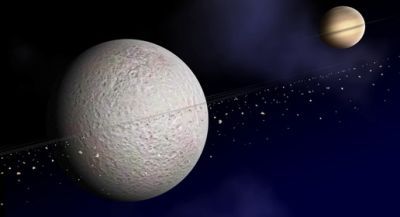11 March 2008

An artist’s concept of the material encircling Rhea, Saturn’s second largest moon
Courtesy of NASA/JPL/JHUAPL
Saturn’s magnificent rings were discovered by Galileo in 1610. During the Space Age, three more planetary rings were discovered, the faint ring systems of Uranus, Jupiter and Neptune, respectively. Recent observations by NASA’s Cassini spacecraft posed an intriguing question: Could a moon have rings?
The Saturn-bound Cassini spacecraft has found evidence of material around Rhea, Saturn’s second largest moon. This would be the first discovery of a ring around a planetary moon.
Six Cassini instruments, designed to study the atmospheres and particles around Saturn and its moons, appear to have detected a broad debris disc and at least one ring around Rhea (1,528 km across).
"Until now, only planets were known to have rings, but now Rhea seems to have some family ties to its ringed parent Saturn," said Geraint Jones, a Cassini scientist and lead author of an article that appeared in the journal Science on the 7th of March.
The apparent debris disk measures several thousand miles across. The disc and the rings contain particles believed to range in size from pebbles up to boulders. A dust cloud may extend for 5,900 km from the Rhea's center.
Following the startling discovery, Cassini scientists have carried out numerical simulations to determine if Rhea can maintain rings. The models show that rings formed around Rhea could be sustained for a very long time.
The discovery was a result of a Cassini close flying close to Rhea in November 2005, it is then that instruments on the spacecraft observed the space environment of the moon. Three instruments sampled dust directly. The existence of some debris was expected because a rain of dust continuously hits Saturn's moons, including Rhea, flinging particles off their surfaces.
Other instruments' observations showed how Rhea was interacting with Saturn's magnetosphere, and ruled out the possibility of the existence of an atmosphere. A gradual decrease in the number of electrons around Rhea, detected by two Cassini instruments, indicated the presence of a debris disk, in addition to the tenuous dust cloud.
Material near Rhea probably was shielding Cassini from the common rain of electrons. Evidence for rings located within the debris disk was acquired by Cassini's Magnetospheric Imaging Instrument, which detected sharp, brief falls in electron numbers on both sides of Rhea.
The rings of Uranus were discovered in a similar observation, by NASA's Kuiper Airborne Observatory in 1977, when the planet passed in front of a star, giving rise to fluctuations in the brightness of the star.
"Seeing almost the same signatures on either side of Rhea was the clincher," explained Jones. "After ruling out many other possibilities, we said these are most likely rings. No one was expecting rings around a moon."
It is presumed that these rings are remnants from an ancient collision between Rhea and an asteroid or a comet. Such a collision may have released large quantities of gas and solid particles around Rhea. The gas later dissipated, and only the ring particles remained. Other moons of Saturn, such as Mimas, show evidence of a tremendous collision that could have shattered the moon.
Initial observations by the imaging team when Rhea was near the Sun in the sky did not detect dust near the moon remotely. Additional observations are scheduled to search for the larger particles.
"The diversity in our Solar System never fails to amaze us," said Candy Hansen, co-author and Cassini scientist on the Ultraviolet Imaging Spectrograph at NASA's Jet Propulsion Laboratory (JPL). "Many years ago we thought Saturn was the only planet with rings. Now we may have a moon of Saturn that is a miniature version of its even more elaborately decorated parent."
Further Reading
Unlocking Saturn’s Secrets
http://www.nasa.gov/mission_pages/cassini/main/index.html?msource=03908&tr=y&auid=3446795
Cassini-Huygens Mission to Saturn
http://saturn.jpl.nasa.gov/home/index.cfm
Aymen Mohamed Ibrahem
Senior Astronomy Specialist